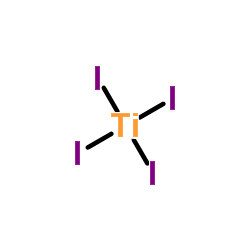7720-83-4
| 中文名 | 碘化钛(IV) |
|---|---|
| 英文名 | titanium (iv) iodide |
| 中文别名 |
碘化钛(Ⅳ)
四碘化钛 |
| 英文别名 |
iodine titanium
Titanium(4+) tetraiodide MFCD00043077 Titanium (IV) iodide Titanium(IV) iodide EINECS 231-754-0 titanium iodide TITANIUM TETRAIODIDE iodide titanium |
| 密度 | 4.3 g/cm3 |
|---|---|
| 沸点 | 377,1ºC |
| 熔点 | 150-151ºC |
| 分子式 | I4Ti |
| 分子量 | 555.485 |
| 精确质量 | 555.565796 |
| LogP | 3.54280 |
| 外观性状 | 红色-棕色晶体 |
| 储存条件 | 干性的保护气体下处置, 保持贮藏器密封 放入紧密的贮藏器内,储存在阴凉,干燥的地方 |
| 稳定性 | 如果遵照规格使用和储存则不会分解 避免接触水分/潮湿.在100~125℃有晶型转变点,高温型为立方晶系晶体,低温型晶体的对称性降低。吸湿性极强。溶于水并水解、发烟。难溶于石油醚。易溶于苯,更易溶于二硫化碳。 |
| 计算化学 | 1.疏水参数计算参考值(XlogP):无 2.氢键供体数量:0 3.氢键受体数量:0 4.可旋转化学键数量:0 5.互变异构体数量:无 6.拓扑分子极性表面积0 7.重原子数量:5 8.表面电荷:0 9.复杂度:19.1 10.同位素原子数量:0 11.确定原子立构中心数量:0 12.不确定原子立构中心数量:0 13.确定化学键立构中心数量:0 14.不确定化学键立构中心数量:0 15.共价键单元数量:1 |
| 更多 | 1. 性状:具有光泽的暗红褐色结晶。 2. 密度(g/mL 25ºC):4.40 3. 相对蒸汽密度(g/mL,空气=1):未确定 4. 熔点(ºC):150 5. 沸点(ºC,常压):377.2 6. 沸点(ºC,5.2kPa):未确定 7. 折射率(n20/D):未确定 8. 闪点(ºC,):未确定 9. 比旋光度(º):未确定 10. 自燃点或引燃温度(ºC):未确定 11. 蒸气压(kPa,25ºC):未确定 12. 饱和蒸气压(kPa,60ºC):未确定 13. 燃烧热(KJ/mol):未确定 14. 临界温度(ºC):未确定 15. 临界压力(KPa):未确定 16. 油水(辛醇/水)分配系数的对数值(25℃):未确定 17. 爆炸上限(%,V/V):未确定 18. 爆炸下限(%,V/V):未确定 19. 溶解性(mg/mL):溶于水,易水解 |
|
Section 1: Product Identification Chemical Name:Titanium (IV) iodide (99.99%-Ti) PURATREM CAS Registry Number:7720-83-4 Formula:TiI4 EINECS Number:231-754-0 Chemical Family:metal halide Synonym:Titanium tetraiodide
Section 2: Composition and Information on Ingredients IngredientCAS NumberPercentACGIH (TWA)OSHA (PEL) Title Compound7720-83-4100%no datano data Section 3: Hazards Identification Corrosive to skin, eyes, and mucous membranes. May cause coughing, wheezing, shortness of breath, Emergency Overview: headache, nausea and vomiting. Ingestion may cause damage to the mouth, throat and esophagus. Primary Routes of Exposure:Ingestion, inhalation, skin, eyes. Eye Contact:Corrosive to eyes. Skin Contact:Corrosive to skin. Inhalation:Inhalation may cause inflammation of the respiratory tract, edema and chemical pneumonitis. Ingestion:Ingestion may cause damage to the mouth, throat and esophagus. Corrosive to skin, eyes and mucous membranes. Inhalation causes coughing, wheezing, shortness of breath, Acute Health Affects: headache, nausea, and vomiting. Ingestion may cause damage to the mouth throat and esophagus. Chronic ingestion of iodides may produce iodism. Symptoms include skin rash, running nose, headache and Chronic Health Affects: irritation of mucous membranes. NTP:No IARC:No OSHA:No SECTION 4: First Aid Measures Immediately flush the eyes with copious amounts of water for at least 10-15 minutes. A victim may need Eye Exposure: assistance in keeping their eye lids open. Get immediate medical attention. Wash the affected area with water. Remove contaminated clothes if necessary. Seek medical assistance if Skin Exposure: irritation persists. Remove the victim to fresh air. Closely monitor the victim for signs of respiratory problems, such as difficulty Inhalation: in breathing, coughing, wheezing, or pain. In such cases seek immediate medical assistance. Seek medical attention immediately. Keep the victim calm. Give the victim water (only if conscious). Induce Ingestion: vomiting only if directed by medical personnel. SECTION 5: Fire Fighting Measures Flash Point:not applicable Autoignition Temperature:none Explosion Limits:none Extinguishing Medium:none required If involved in a fire, fire fighters should be equipped with a NIOSH approved positive pressure self-contained Special Fire Fighting Procedures: breathing apparatus and full protective clothing. Hazardous Combustion andIf involved in a fire this material may emit corrosive hydrogen iodide fumes. Decomposion Products: Unusual Fire or Explosion Hazards: No unusual fire or explosion hazards. SECTION 6: Accidental Release Measures Small spills can be mixed with powdered sodium bicarbonate, lime, or calcium carbonate and swept up. Spill and Leak Procedures:Spillage in areas not adequately ventilated may require an evacuation of area. Emergency response teams will require self-contained breathing apparatus. SECTION 7: Handling and Storage Store material in a tightly sealed bottle away from moisture. If possible, handle material in an efficient fume Handling and Storage: hood. Prolonged exposure to the atmosphere may lead to degradation of the product. SECTION 8: Exposure Controls and Personal Protection Eye Protection:Always wear approved safety glasses when handling a chemical substance in the laboratory. Skin Protection:Wear protective clothing and gloves. Consult with glove manufacturer to determine the proper type of glove. Ventilation:If possible, handle the material in an efficient fume hood. In the absence of adequate ventilation a respirator should be worn. The use of a respiratory requires a Respirator: Respirator Protection Program to be in compliance with 29 CFR 1910.134. Ventilation:If possible, handle the material in an efficient fume hood. Additional Protection:No additional protection required. SECTION 9: Physical and Chemical Properties Color and Form:black xtl. Molecular Weight:555.52 Melting Point:150° Boiling Point:377.1°C Vapor Pressure:no data Specific Gravity:4.3 Odor:Pungent odor. Solubility in Water:reacts with water SECTION 10: Stability and Reactivity Stability:moisture sensitive Hazardous Polymerization:no hazardous polymerization Conditions to Avoid:contact with moisture Incompatibility:Oxidizing agents, water, alcohols, active metals and halogens Decomposition Products:with moisture: hydrogen iodide SECTION 11: Toxicological Information RTECS Data:No information available in the RTECS files. Carcinogenic Effects:no data Mutagenic Effects:no data Tetratogenic Effects:no data SECTION 12: Ecological Information Ecological Information:No information available SECTION 13: Disposal Considerations Disposal:Dispose of according to local, state and federal regulations. SECTION 14: Transportation Shipping Name (CFR):Corrosive Solid, Acidic, Inorganic, N.O.S. Hazard Class (CFR):8 Additional Hazard Class (CFR):NA Packaging Group (CFR):II UN ID Number (CFR):UN# 3260 Shipping Name (IATA):Corrosive Solid, Acidic, Inorganic, N.O.S. Hazard Class (IATA):8 Additional Hazard Class (IATA):NA Packaging Group (IATA):II UN ID Number (IATA):UN# 3260 SECTION 15: Regulatory Information TSCA:Listed in the TSCA inventory. SARA (Title 313):Title compound not listed. Second Ingredient:none SECTION 16 - ADDITIONAL INFORMATION N/A |
|
生态学数据: 对水是稍微危害的,若无政府许可,勿将材料排入周围环境
|
| 符号 |

GHS05 |
|---|---|
| 信号词 | Danger |
| 危害声明 | H314 |
| 警示性声明 | P280-P305 + P351 + P338-P310 |
| 个人防护装备 | Eyeshields;Faceshields;full-face particle respirator type N100 (US);Gloves;respirator cartridge type N100 (US);type P1 (EN143) respirator filter;type P3 (EN 143) respirator cartridges |
| 危害码 (欧洲) | C |
| 风险声明 (欧洲) | R34 |
| 安全声明 (欧洲) | 26-36/37/39-45 |
| 危险品运输编码 | UN3260 |
| 包装等级 | II |
|
~% 
7720-83-4 |
| 文献:Ann. Chim. Phys., , vol. 9, p. 229 - 237 Comptes Rendus Hebdomadaires des Seances de l'Academie des Sciences, , vol. 120, p. 290 - 296 Ti: MVol., 3.5, page 189 - 199 |
|
~% 
7720-83-4 |
| 文献:Bulletin de la Societe Chimique de France, , p. 201 - 203 Jahresbericht ueber die Fortschritte der Chemie und Verwandter Theile Anderer Wissenschaften, , p. 207 |
|
~% 
7720-83-4 |
| 文献:Bulletin de la Societe Chimique de France, , p. 201 - 203 Jahresbericht ueber die Fortschritte der Chemie und Verwandter Theile Anderer Wissenschaften, , p. 207 |
|
~0% 
7720-83-4 |
| 文献:Denes Georges Journal of Solid State Chemistry, 1988 , vol. 77, p. 54 - 59 |
|
~% 
7720-83-4 |
| 文献:Bulletin de la Societe Chimique de France, , vol. 7, p. 198 Bulletin de la Societe Chimique de France, , vol. 7, p. 201 - 201 I: MVol.2, 21, page 291 - 293 |
|
~99% 
7720-83-4 |
| 文献:Troyanov, S. I.; Mazo, G. N. Russian Journal of Inorganic Chemistry (Translation of Zhurnal Neorganicheskoi Khimii), 1988 , vol. 33, p. 499 - 501 Zhurnal Neorganicheskoi Khimii, 1988 , vol. 33, p. 889 - 892 |
|
~% 
7720-83-4 |
| 文献:Journal of Physical Chemistry, , vol. 8, p. 500 - 504 |
| 上游产品 5 | |
|---|---|
| 下游产品 5 | |











